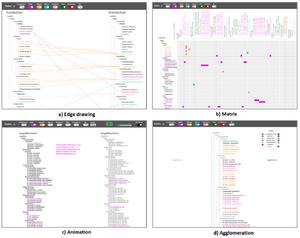Die Arbeitsgruppe zieht um!
Wir wechseln im Wintersemester 2021/22 an die Universität Bamberg. Ab 15. Oktober 2021 übernimmt Fabian Beck den dortigen Lehrstuhl für Informationsvisualisierung.
Neue Webseite der Arbeitsgruppe: https://www.uni-bamberg.de/vis
Publikationen
Publikationen der Arbeitsgruppe, die seit 2016 erschienen sind. Frühere Publikationen von Fabian Beck sind auf Google Scholar oder DBLP zu finden.

Art der Publikation: Beitrag in Zeitschrift
An expert study on hierarchy comparison methods applied to biological taxonomies curation
- Autor(en):
- Sancho-Chavarría, Lilliana; Beck, Fabian; Mata-Montero, Erick
- Titel der Zeitschrift:
- PeerJ Computer Science
- Veröffentlichung:
- 2020
- Heftnummer:
- 6:e277
- Digital Object Identifier (DOI):
- doi:10.7717/peerj-cs.277
- Zitation:
- Download BibTeX
Kurzfassung
Comparison of hierarchies aims at identifying differences and similarities between two or more hierarchical structures. In the biological taxonomy domain, comparison is indispensable for the reconciliation of alternative versions of a taxonomic classification. Biological taxonomies are knowledge structures that may include large amounts of nodes (taxa), which are typically maintained manually. We present the results of a user study with taxonomy experts that evaluates four well-known methods for the comparison of two hierarchies, namely, edge drawing, matrix representation, animation and agglomeration. Each of these methods is evaluated with respect to seven typical biological taxonomy curation tasks. To this end, we designed an interactive software environment through which expert taxonomists performed exercises representative of the considered tasks. We evaluated participants’ effectiveness and level of satisfaction from both quantitative and qualitative perspectives. Overall quantitative results evidence that participants were less effective with agglomeration whereas they were more satisfied with edge drawing. Qualitative findings reveal a greater preference among participants for the edge drawing method. In addition, from the qualitative analysis, we obtained insights that contribute to explain the differences between the methods and provide directions for future research.
